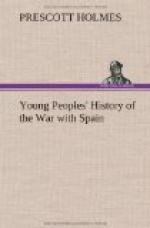Now I will tell you the story of how the United States flag was raised for the first time on the island of Cuba during the war; and I will tell it in the words of Ensign Willard, of the Machias, the officer who performed the deed. It was done while the fight was going on in Cardenas harbor.
“The Machias drew too much water for the channel to the eastward, and moved up the main channel to within one mile of its narrowest part abreast of Diana Cay. This channel was supposed to be mined and the mines operated from the blockhouse and signal station on Diana Cay. This place was shelled, and, under cover of this fire, a boat’s crew of nineteen sailors and marines, under my command, made a landing on the opposite side of the Cay.
“The Spanish hastily left the place, disappearing completely. A Spanish flag, signal flags, etc., and a quantity of ammunition, were captured, and the United States flag raised. Then search was made for mines and the channel dragged for two hours. Before leaving, everything at the station was burned or destroyed, including nine large row-boats. For the raising of this flag I was later awarded, through the New York ‘Herald,’ a prize of one hundred dollars, which was divided pro rata by me among the men who accompanied me on the expedition.”
Early in June, brave work was done by our sailors at Guantanamo, a short distance east of Santiago. They took the harbor and destroyed the forts there, in order that our ships might have a place where they could get coal without going far from Santiago. The coal steamers could not supply the whole fleet, so our vessels had been going for coal all the way back to Key West, south of Florida. It was a great help to have a coaling place at Guantanamo, but our sailors had much hard work to take the place. Now I will tell you about some of this hard work, and something about two men who made it possible to land the marines and establish a coaling station in Guantanamo Bay. The men were Commander McCalla, of the Marblehead, and Captain Brownson, of the Yankee.
[Illustration: Commander B.H. McCalla.]
Long before the Spanish fleet put into the harbor of Santiago, the Marblehead was along the southern coast of Cuba, poking her nose into every inlet, cutting cables, and communicating with the Cubans. McCalla had her stripped of everything but her guns and her steering gear, and everywhere she went she became a terror to the Spaniards. She dared to go anywhere and do anything. Every man on the ship was devoted to McCalla, and every gunner on board was a crack shot, because they were kept shooting at something all the time. If they couldn’t find a Spanish gunboat to shoot at, they fired at floating targets.
When it was decided to clear everything Spanish out of the bay, so our ships could use it, McCalla and Brownson were sent down there to do the work; but first I will tell you a story about Brownson, so you can see that he was just the right kind of a man to go along with McCalla.




